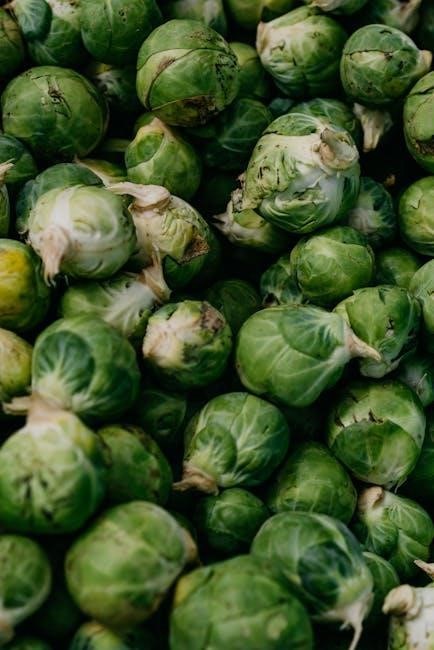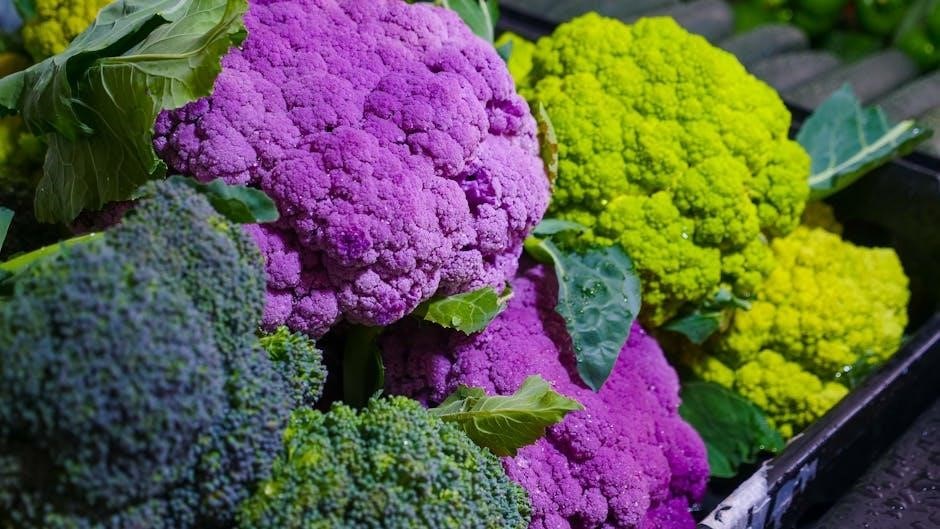Cruciferous vegetables are nutritious and healthy food options, including arugula and broccoli, with many benefits for overall health and wellbeing naturally every day․
Definition and Classification
The Brassicaceae family, also known as cruciferous vegetables, includes many economically important species, mainly edible oil plants, vegetable species, spice plants, and feed plants․
This family of vegetables is defined by their four-petaled flowers, which resemble a cross, hence the name cruciferous․
Classification of cruciferous vegetables is based on their botanical characteristics, and they are part of the Brassica genus, which includes broccoli, cauliflower, and kale․
These vegetables are further classified into different species, each with their unique characteristics and nutritional profiles․
Understanding the definition and classification of cruciferous vegetables is essential to appreciating their diversity and importance in a healthy diet․
The classification of cruciferous vegetables also helps to identify their potential health benefits and uses in different culinary and medicinal applications․
Examples of Cruciferous Vegetables
Cruciferous vegetables include a wide range of edible plants, such as arugula, bok choy, broccoli, broccoli rabe, and broccolini․
Other examples include Brussels sprouts, cabbage, cauliflower, collards, horseradish, kale, kohlrabi, mustard greens, and radish․
Red cabbage, rutabaga, turnip, turnip greens, and watercress are also part of this vegetable family․
These vegetables can be consumed raw or cooked, and are often used in a variety of dishes, from salads to soups and stir-fries․
Some cruciferous vegetables, like kale and collards, are also used as garnishes or added to smoothies for their nutritional benefits․
The diversity of cruciferous vegetables offers a range of flavors, textures, and nutritional profiles, making them a great addition to a healthy and balanced diet, with many options to choose from․

Nutritional Value of Cruciferous Vegetables
Cruciferous vegetables are rich in fiber, vitamins, and minerals naturally every day․
Antioxidants and Phytochemicals
Cruciferous vegetables contain antioxidants, particularly beta carotene and sulforaphane, which have been shown to have numerous health benefits․ These phytochemicals have been found to have anti-inflammatory properties and can help protect against cell damage․ The antioxidants present in cruciferous vegetables can also help to reduce the risk of chronic diseases, such as heart disease and cancer․ Additionally, the phytochemicals in these vegetables have been found to have anti-cancer properties, and can help to prevent the growth and spread of cancer cells․ The high levels of antioxidants and phytochemicals in cruciferous vegetables make them a nutritious and healthy addition to a balanced diet․ They can be consumed raw or cooked, and can be added to a variety of dishes, including salads, soups, and stir-fries․ Overall, the antioxidants and phytochemicals in cruciferous vegetables make them a valuable component of a healthy diet․
Vitamins and Minerals

Cruciferous vegetables are rich in vitamins and minerals, including vitamin A, vitamin C, and folate․ They are also a good source of minerals such as calcium, iron, and potassium․ These vitamins and minerals are essential for maintaining good health and can help to prevent a range of diseases․ Vitamin C, for example, is important for immune function, while folate is crucial for cell growth and development․ The high levels of calcium in cruciferous vegetables can also help to support bone health, reducing the risk of osteoporosis and fractures․ Additionally, the iron present in these vegetables can help to prevent anemia, a condition characterized by low red blood cell count․ Overall, the vitamins and minerals in cruciferous vegetables make them a nutritious and healthy addition to a balanced diet, providing a range of essential nutrients․ They are a valuable component of a healthy eating plan․

Health Effects of Cruciferous Vegetables
Cruciferous vegetables have numerous health benefits naturally every day․
Cancer Prevention
Cruciferous vegetables have been found to have a potential role in cancer prevention, with studies suggesting that they may help to reduce the risk of certain types of cancer․ The antioxidants and phytochemicals present in these vegetables, such as sulforaphane and indole-3-carbinol, have been shown to have anti-cancer properties․ These compounds have been found to inhibit the growth of cancer cells and induce apoptosis, or cell death, in various types of cancer, including breast, prostate, and colon cancer․ Additionally, the fiber and vitamins present in cruciferous vegetables may also help to support healthy cell growth and reduce inflammation, which can contribute to cancer development․ Overall, incorporating cruciferous vegetables into a healthy diet may be a useful strategy for reducing the risk of cancer and promoting overall health․ Regular consumption of these vegetables may have a positive impact on cancer prevention․
Other Health Benefits
Cruciferous vegetables have been found to have numerous health benefits beyond cancer prevention, including supporting heart health and reducing inflammation․ The fiber, vitamins, and minerals present in these vegetables may help to lower cholesterol levels and improve blood lipid profiles, reducing the risk of cardiovascular disease․ Additionally, the antioxidants and phytochemicals in cruciferous vegetables may help to reduce oxidative stress and inflammation, which can contribute to a range of chronic diseases, including arthritis and neurodegenerative disorders․ Regular consumption of cruciferous vegetables may also support healthy digestion and immune function, reducing the risk of illnesses such as the common cold and flu․ Overall, incorporating cruciferous vegetables into a healthy diet may have a range of health benefits, supporting overall wellbeing and reducing the risk of chronic disease․ A healthy diet rich in cruciferous vegetables is essential for maintaining good health․
Cruciferous vegetables are essential for a healthy diet and lifestyle naturally every day always․
Importance of Cruciferous Vegetables
Cruciferous vegetables are a vital part of a healthy diet, providing essential nutrients and health benefits․ They are rich in fiber, vitamins, and minerals, and contain phytochemicals that have been shown to have numerous health benefits․ The importance of cruciferous vegetables lies in their ability to reduce the risk of chronic diseases, such as heart disease, diabetes, and certain types of cancer․ They are also high in antioxidants, which help to protect cells from damage and reduce inflammation․ Furthermore, cruciferous vegetables are low in calories and high in fiber, making them a great addition to a weight loss diet․ Overall, the importance of cruciferous vegetables cannot be overstated, and they should be included in a healthy and balanced diet․ A list of cruciferous vegetables can be found in various online resources, including pdf files, to help individuals make informed choices about their diet․
Encouragement to Eat More Cruciferous Vegetables

Eating more cruciferous vegetables can have a significant impact on overall health and wellbeing․ To encourage consumption, individuals can start by incorporating a variety of cruciferous vegetables into their meals․ Online resources, such as pdf files, can provide a list of cruciferous vegetables and offer tips on how to prepare them․ Additionally, individuals can experiment with different recipes and cooking methods to find ways to make cruciferous vegetables more enjoyable․ By making a few simple changes to their diet, individuals can increase their intake of cruciferous vegetables and experience the numerous health benefits they provide․ With a little creativity and experimentation, cruciferous vegetables can become a delicious and integral part of a healthy diet․ By eating more cruciferous vegetables, individuals can take a proactive approach to maintaining their health and reducing the risk of chronic diseases․